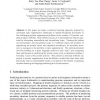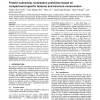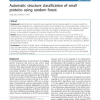508 search results - page 25 / 102 » A graphical model for protein secondary structure prediction |
ISMIS
2005
Springer
14 years 1 months ago
2005
Springer
In this paper, we adapt a statistical learning approach, inspired by automated topic segmentation techniques in speech-recognized documents to the challenging protein segmentation ...
BMCBI
2007
13 years 8 months ago
2007
Motivation: Protein subcellular localization is crucial for genome annotation, protein function prediction, and drug discovery. However, since determining subcellular localization...
BMCBI
2010
13 years 8 months ago
2010
Background: Random forest, an ensemble based supervised machine learning algorithm, is used to predict the SCOP structural classification for a target structure, based on the simi...
ICPR
2006
IEEE
14 years 9 months ago
2006
IEEE
Protein fold recognition has been the focus of computational biologists for many years. In order to map a protein primary structure to its correct 3D fold, we introduce in this pa...
BMCBI
2007
13 years 8 months ago
2007
Background: Selecting the highest quality 3D model of a protein structure from a number of alternatives remains an important challenge in the field of structural bioinformatics. M...



